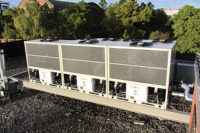If looking at your service department’s reports fills you with despair, it’s time to reconsider how you’ve been running this side of the business. According to HVAC industry leaders, while there are a few common pitfalls to running a successful service operation, a profitable and successful service department is attainable.
Common Pitfalls
According to Ben Stark, co-founder, Success4Others, “One of the most common mistakes contractors make on the service and maintenance side of their businesses is assuming the department normally runs at a loss due to the need for it to produce leads for replacement sales.
“This is generally caused by lower profit margins being used to be competitive.”
Frank Besednjak, a business coach, motivational speaker, and president of Training Source Inc., said one of the most common mistakes he sees contractors make is “pricing too low.” He also said many contractors fail to set goals and measure performance, and — worst of all — they “think they know everything already.”
This know-it-all attitude makes it hard for HVAC contractors to improve and consider new approaches to their service operations. Not only do many fall into the “know-it-all” camp, Besednjak said they also “have a tendency to have blinders on to new or different products, services, or ideas from anyone outside of their circle or group.”
For instance, he pointed to one common industry practice that he doesn’t understand — “giving your service techs only one call at a time.” This practice and others like it, he said, are accepted as standard by the industry when they should be questioned by contractors seeking to improve their companies and profits.
“Contractors need to consider changing the 1980s mentality,” he said. “The practices that made a company successful in the past don’t necessarily work today.”
Performance Indicators and Pricing
As the business adage goes, you can’t improve what you can’t measure. So, it’s important that contractors track key performance indicators to gain an accurate view of how their service department is operating.
The most important indicators to track are cost per call, revenue per call, and customer satisfaction, according to Besednjak.
Stark added that technicians need to know what their boss is looking for, such as average ticket, number of service agreements per service calls run, and number of sales leads produced per number of calls run.
“You cannot expect to just say, ‘Now go out and be profitable,’” he said. “If a service or maintenance tech knows what is expected of him or her, they will do a much better job of trying to fulfill the owner or manager’s wants.”
According to Richard Harshaw, founder of Lodestar Consulting, tracking and reporting are key to making the service department profitable.
“Companies that offer top-notch service often experience net profit margins above 20 percent in the service department, and often above 10 percent for the company overall. Such metrics are only sustainable when the company generates a monthly departmentalized income statement, a document that shows not only the company’s overall financial performance for the month, but also the details for each department in the company [such as installation and service],” Harshaw said. “Only by having a service department’s income statement reported as if the service department was a stand-alone division can an owner properly manage costs and set prices that ensure the generation of a net profit.”
Both Harshaw and Stark promote the benefits of flat rate pricing.
“It is important to use your service call pricing to remain competitive or flexible to demand,” Stark said. “But always look at your repair task pricing to put your company in the black. This is overcome by understanding financials better and using production pay and flat rate pricing to improve gross margins in the department.”
To make an even stronger case for flat rate pricing, Harshaw provided some insight into a typical scenario with a homeowner.
“To be profitable on a time-and-material basis, a contractor needs to charge a minimum of three times his highest-paid service technician’s wages — including benefits — and that will take the hourly rate of service above $100 per hour in most cases. A homeowner who makes $35 an hour has a hard time with a service technician charging $100 per hour,” he said, adding, “Especially in those cases where the technician has a slovenly appearance and rude manners.”
Customer Satisfaction
Of course, unkempt and impolite technicians are not what HVAC contractors are hoping to send into the field. And putting forth true effort to improve the customer experience will ultimately benefit the bottom line of the service department.
“I don’t care if you fixed it. That is the minimum you should provide,” Besednjak said. “Realize that customers will measure the value of services based on the overall experience encountered.”
Stark added that customers are looking for the best value, and they will be impressed by the little things a technician does during a service call.
“Show this by going the extra mile while on the call,” he said. “Do the small stuff. Cut back overgrown shrubs around the outdoor unit, clean up around the furnace and the ceiling fans’ blades, and take a few minutes to do any other easy-to-do item on behalf of the customer.”
Based on his experience in the industry, Harshaw believes the majority of HVAC contractors have not embraced a customer-focused culture. However, those who do truly strive to keep customers satisfied achieve much higher net profit margins, he said.
“Those few who understand the customer-focused culture and charge fees in accordance with that culture are the ones who typically enjoy the greatest profits and have the happiest and most loyal customers,” he said.
Publication date: 8/18/2014
Want more HVAC industry news and information? Join The NEWS on Facebook, Twitter, and LinkedIn today!










